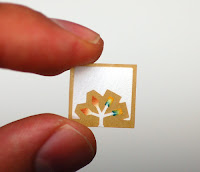Start your engines
Posted by
Carl Batt
at
9/15/2010 05:44:00 AM
0
comments
![]()
![]()
Just like Mother Nature
 |
| Sea urchins that could be a new kind of solar cell |
http://www.empa.ch/
Posted by
Carl Batt
at
8/18/2010 12:00:00 PM
0
comments
![]()
![]()
Forget about the TV, remote control the worm
For more information
Posted by
Carl Batt
at
7/13/2010 10:39:00 AM
0
comments
![]()
![]()
Don't blow your gasket

But if you do, there is a product to fix that. The people at CRC who make a lot of different products to fix your car have a new product to fix gaskets. Normally if you blow a gasket in a car engine you have to take everything apart and replace the gasket. This stuff apparently eliminates that problem "Using Nanotechnology, this product fills in cracks and crevices other products can't, making a stronger, more solid bond that's permanently hardened to the surface area." Nanooze hasn't tried this but hey nanotechnology saves the day (again).http://tinyurl.com/nanogasket
Posted by
Carl Batt
at
7/13/2010 10:30:00 AM
0
comments
![]()
![]()
How smart are your drawers?
for more info http://tinyurl.com/smartshorts
Posted by
Carl Batt
at
6/24/2010 10:31:00 AM
0
comments
![]()
![]()
Nano tattoo
Scientists at MIT have developed a tattoo that can measure the amount of sugar in your blood. Read more about it in the upcoming issue of Nanooze due out in July 2010.
Posted by
Carl Batt
at
6/11/2010 10:42:00 AM
0
comments
![]()
![]()
calling Nemo
for more information
Posted by
Carl Batt
at
6/09/2010 02:15:00 PM
0
comments
![]()
![]()
It's different up there
Posted by
Carl Batt
at
5/13/2010 11:57:00 AM
0
comments
![]()
![]()
Ouch
http://tinyurl.com/nanopatch
Posted by
Carl Batt
at
4/30/2010 12:41:00 PM
0
comments
![]()
![]()
Sensing things around us
Posted by
Carl Batt
at
4/12/2010 06:37:00 AM
0
comments
![]()
![]()
Seeing is believing
To learn more go to:
http://tinyurl.com/DNAview
Posted by
Carl Batt
at
4/08/2010 04:18:00 PM
0
comments
![]()
![]()
Build your own (not so nano but fun) bot
Posted by
Carl Batt
at
3/30/2010 06:17:00 AM
0
comments
![]()
![]()
Keeping 'em honest
http://tinyurl.com/olympicnano
Posted by
Carl Batt
at
3/28/2010 10:26:00 AM
0
comments
![]()
![]()
One hair at a time
Posted by
Carl Batt
at
3/07/2010 11:52:00 AM
0
comments
![]()
![]()
Power up while you boggie
 It takes energy to move. Move to the kitchen, to school, to the couch. And there is a lot of energy that can be captured from these movements. Maybe you have a pair of those sneakers with the lights? They capture the energy from walking and uses it to power a few tiny light bulbs. Now scientists are trying to take it to the next level by developing more sophisticated nanodevices and make them cheaper. They use these things called piezoelectric crystals. Piezoelectric things have been around since the mid-18th century but these new ones are printed and they can be printed onto flexible materials that are also biocompatible. So maybe you don't want them stitched to the bottom of your feet but perhaps they can be stuck onto a lot of different things making energy for all sorts of devices. No more need to change the battery unless you become a couch potato.
It takes energy to move. Move to the kitchen, to school, to the couch. And there is a lot of energy that can be captured from these movements. Maybe you have a pair of those sneakers with the lights? They capture the energy from walking and uses it to power a few tiny light bulbs. Now scientists are trying to take it to the next level by developing more sophisticated nanodevices and make them cheaper. They use these things called piezoelectric crystals. Piezoelectric things have been around since the mid-18th century but these new ones are printed and they can be printed onto flexible materials that are also biocompatible. So maybe you don't want them stitched to the bottom of your feet but perhaps they can be stuck onto a lot of different things making energy for all sorts of devices. No more need to change the battery unless you become a couch potato.
http://tinyurl.com/ygbr3g3
read about the original science http://pubs.acs.org/doi/abs/10.1021/nl903377u
Posted by
Carl Batt
at
3/01/2010 05:10:00 PM
0
comments
![]()
![]()
Lab on a stamp
Posted by
Carl Batt
at
2/26/2010 11:35:00 AM
0
comments
![]()
![]()
Nanooze the exhibit opens at EPCOT, Walt Disney World
Posted by
Carl Batt
at
2/22/2010 08:41:00 PM
1 comments
![]()
![]()
Tiny layer of glass
Posted by
Carl Batt
at
2/07/2010 07:32:00 AM
0
comments
![]()
![]()
Plants do it already
for more see
http://www.gizmodo.com.au/2010/01/tobacco-plants-used-to-grow-cheap-solar-cells/
Posted by
Carl Batt
at
1/31/2010 09:33:00 AM
0
comments
![]()
![]()
Your brain as a mold.
Posted by
Carl Batt
at
1/31/2010 09:16:00 AM
0
comments
![]()
![]()















